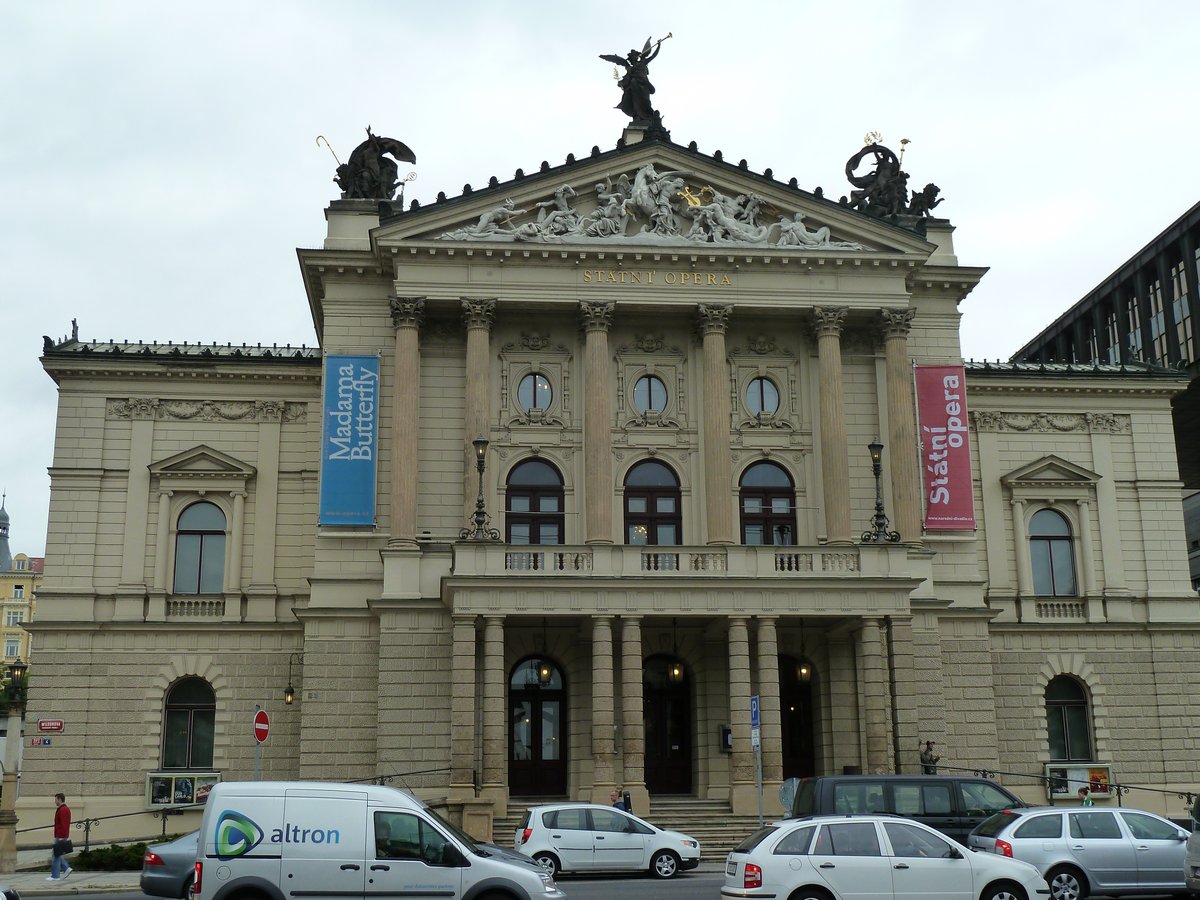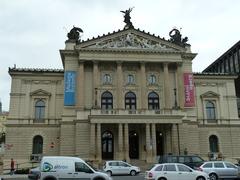
State Opera Prague Visiting Hours, Tickets, and Guide to Prague Historical Sites
Date: 14/06/2025
Introduction
Situated in the heart of Prague, the State Opera Prague is an architectural and cultural landmark, blending a storied legacy with contemporary innovation. Originally inaugurated in 1888 as the Neues Deutsches Theater, this venue is renowned for its Neo-Renaissance and Neo-Rococo design, world-class performances, and pivotal role in the city’s multicultural history. Whether you are an opera enthusiast, a history aficionado, or a traveler eager to explore Prague’s cultural treasures, this guide provides all essential information, from visiting hours and ticketing to guided tours, accessibility, and nearby attractions (prague-guide.co.uk; czechbyjane.com; funinprague.eu).
Table of Contents
- History and Architectural Heritage
- Recent Restorations and Modern Features
- Artistic Legacy and Performances
- Visiting Hours and Ticket Information
- Guided Tours and Visitor Experience
- Accessibility and How to Get There
- Nearby Attractions and Recommendations
- Insider Tips for Visitors
- Frequently Asked Questions (FAQ)
- Conclusion and Resources
History and Architectural Heritage
Foundations and Early Years
Opened on January 5, 1888, as the Neues Deutsches Theater, the State Opera Prague was conceived by Prague’s German-speaking community, showcasing a harmonious blend of Czech and German cultural traditions (viewfromprague.com). The building, designed by Viennese architects Ferdinand Fellner and Hermann Helmer, epitomizes Neo-Renaissance style with a richly ornamented façade, grand columns, and prominent central dome. Its location, adjacent to Wenceslas Square and the National Museum, positioned it as a central hub for Prague’s cultural life (narodni-divadlo.cz; prague.org).
The sumptuous Neo-Rococo interiors captivate visitors with marble columns, gilded moldings, elaborate chandeliers, and plush red velvet seating. The auditorium, seating over 1,000 guests, boasts outstanding acoustics and a horseshoe layout for excellent sightlines (funinprague.eu).
Transformations Through the 20th Century
The theatre’s identity evolved through major political changes. Post World War I, it served as a bridge between Prague’s German and Czech communities. After World War II, it was renamed the Smetana Theatre in 1949, shifting focus to Czech-language productions. Following the Velvet Revolution, it became the State Opera (Státní opera) in 1989, embracing a diverse international repertoire (viewfromprague.com).
Recent Restorations and Modern Features
A major restoration from 2017 to 2020 revitalized the State Opera at a cost of 1.3 billion CZK, restoring historic grandeur while integrating state-of-the-art technology (hochtief.com). Notable upgrades include:
- Faithful restoration of Neo-Rococo interiors and original murals
- Installation of new seating with multilingual LED subtitle panels
- Advanced stage technology and rotating platform
- Enhanced accessibility with ramps, elevators, and modernized facilities
The re-opening gala in January 2020 marked 132 years since the original inauguration, symbolizing the theatre’s enduring legacy (travelandleisureasia.com).
Artistic Legacy and Performances
The State Opera Prague has hosted legendary artists such as Gustav Mahler, Richard Strauss, Maria Jeritza, and Enrico Caruso. Its repertoire features Italian, German, French, Russian, and Czech masterpieces, with regular opera and ballet seasons from September to June (pragueticketoffice.com). Seasonal highlights include:
- Verdi’s La traviata and Aida
- Dvořák’s Rusalka
- Mozart’s Le nozze di Figaro
- Tchaikovsky’s Swan Lake
Special events and festivals, such as the annual Festival of Musical Theater OPERA, further enrich the cultural calendar (expats.cz).
Visiting Hours and Ticket Information
- Guided Tours: Typically run from 10:00 AM to 6:00 PM; check the official schedule for updates.
- Performances: Most start at 7:00 PM; matinees and special events may vary.
- Tickets: Available online via the National Theatre, at the box office (Wilsonova 4), or through authorized agencies. Prices range from Kč 200 (€8) to Kč 2,000 (€80), with discounts for students, seniors, and groups (prague-guide.co.uk; expats.cz).
Advance booking is advised for popular performances and tours.
Guided Tours and Visitor Experience
Guided tours (in English and other languages) last around 50 minutes and include the foyer, auditorium, historic box office, and exclusive lounges. Visitors learn about the theatre’s architecture, history, and backstage secrets. Photography is permitted on tours but not during performances (narodni-divadlo.cz).
Accessibility and How to Get There
The State Opera is fully accessible, with ramps, lifts, accessible restrooms, and designated seating.
- Location: Wilsonova 4, Prague 1, close to Wenceslas Square and the National Museum
- Metro: Muzeum station (Lines A and C)
- Tram: Stops at Muzeum or Hlavní nádraží
- Parking: Nearby garage; fee applies (narodni-divadlo.cz)
Nearby Attractions and Recommendations
- National Museum (220 meters)
- Wenceslas Square (415 meters)
- Mucha Museum (572 meters)
- Museum of Communism (714 meters)
The surrounding area offers numerous cafés, restaurants, and shops, making it ideal for combining cultural visits with local dining and shopping experiences.
Insider Tips for Visitors
- Matinee Performances: Grant access to the roof terrace for panoramic city views (viewfromprague.com).
- Dress Code: Smart casual for standard performances; formal attire is encouraged for gala events (Prague Ticket Office Recommendations).
- Subtitles: Multilingual LED panels enhance understanding for non-Czech speakers.
- Family-Friendly: Children are welcome; check age recommendations for specific performances.
Frequently Asked Questions (FAQ)
What are the State Opera Prague visiting hours?
Guided tours usually run from 10:00 AM to 6:00 PM; performances begin at 7:00 PM. Confirm specific dates online.
How do I purchase tickets?
Tickets are available via the official website, box office, and authorized vendors. Booking in advance is recommended.
Is the venue accessible?
Yes, with ramps, lifts, and accessible seating options.
Are guided tours available?
Yes, regular tours offer insights into the theatre’s history and architecture.
Can I take photos inside?
Photography is allowed during tours and in public areas, but not during performances.
Conclusion
The State Opera Prague stands as a beacon of artistic and architectural splendor, embodying the enduring spirit of Prague’s cultural life. With its rich legacy, stunning interiors, modern amenities, and central location, it offers an exceptional experience for visitors of all backgrounds. Whether attending a performance, joining a guided tour, or exploring nearby historical sites, the State Opera is a must-see destination.
For up-to-date schedules, tickets, and events, consult the official National Theatre – State Opera and trusted platforms. Enhance your cultural journey with tools like the Audiala app for seamless planning.
Explore more:
Virtual Tour: Virtual Tour of State Opera Prague
Suggested visuals: Include high-resolution images of the opera house’s façade, auditorium, and interactive maps to enrich your trip planning.
References and Further Reading
- State Opera Prague Visiting Hours, Tickets, and Historical Guide, 2023, Prague Guide
- Visiting the State Opera Prague: A Comprehensive Guide to History, Culture, and Practical Information, 2024, Czech By Jane
- Prague State Opera: Visiting Hours, Tickets, and Architectural Highlights, 2023, European Culture
- Experience the State Opera Prague: Visiting Hours, Tickets, History & Visitor Guide, 2024, Introducing Prague
- Official National Theatre Website - State Opera, 2025, National Theatre Prague
- Prague Ticket Office - Opera & Ballet Events, 2025, Prague Ticket Office
- Stunning and Affordable: Explore Prague’s Grand Opera Houses in 2025, 2025, Expats.cz
- State Opera Prague Restoration Project Details, 2020, Hochtief























































































































































































